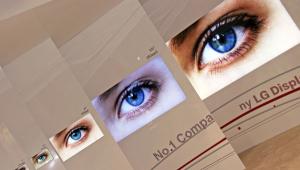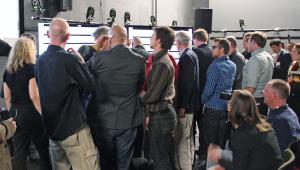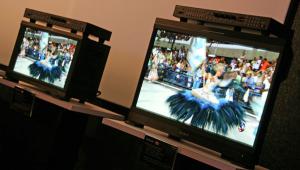NAB 2012: Red Laser Projector & Player

What type of imager does it use? Red would not say, but I have it on relatively good authority that it's LCOS. I did confirm that it's a dual-imager, polarized-3D engine with 4K resolution, allowing each eye to see 4K simultaneously using passive-polarized glasses. And it can accept frames rates up to 120fps in 2D or 60fps for each eye in 3Din fact, it's native refresh rate is 360fps per eye.
Also introduced was the REDray Player (seen on top of and next to the laser module in the photo), a hard-disk-based source device capable of playing 4K 3D material at up to 120fps as well as 7.1 audio from its four HDMI 1.4 outputs. Content is loaded onto the hard disk via gigabit Ethernet, USB, or SD card, and more storage can be added via eSATA.
I was amazed to learn that Red has developed a new codec called REDcode RGB that reduces the bandwidth required for 4K delivery to around 20 megabits per secondthat's right, 4K at a data rate lower than Blu-ray! Red claims it is visually indistinguishable from its REDcode Raw codec, which is used for its camera output at more than 400Mbps, but I'll reserve judgment on that until I can see a direct comparison between the two. The player includes two independent codecsREDcode RGB and H.264for backward compatibility. It will also upconvert lower resolutions to 4K.
The player will be available as a standalone unit forget thisaround $1000! The modular projector package will include a version of the player with an HDMI input and additional video processing, and the cost will depend on how many laser modules you want. Most home theaters will need only one, which is said to be sufficient for screens up to 12 feet wide. And the cost of such a system? Hold on to your hataround $10,000! That's less than half the price of the Sony VPL-VW1000ES with 4K 3D per eye, and it includes a 4K 3D player!
Of course, the distribution of such content is still a big question mark. At 20Mbps, a 4K movie encoded in REDcode RGB can be effectively delivered online or on a thumb drive, removing the last technological hurdle to 4K distribution. But will the studios actually start releasing such high-res content? Only time will tell, though Red's proprietary REDpass DRM (digital rights management) might help persuade them it's safe to do so.
The line to see the REDray demo was easily the longest at the show. Produced by Ridley Scott among others and written and directed by his son Luke Scott, the demo consisted of a short 3D movie entitled Loom, which was shot on Red Epic cameras at 24fps. It's a dystopian vision of a totalitarian future reminiscent of THX 1138, complete with a computerized counselor. But whereas much of THX 1138 looks very bright with lots of light and white walls, many of the scenes in Loom are very dark with low contrast, making it less than ideal as demo material.
Also, the system was not completely dialed inwe were seeing 2K in each eye, and there was some obvious ghosting because there had been a last-minute switch to a Stewart 5D screen, which required some tweakingso the demo didn't look as good as it could have. Still, I hope to visit Red in the near future to learn more about the projector and player, which seem to be game changers in the world of home and commercial cinema.

























































